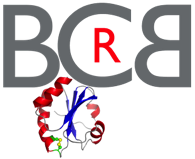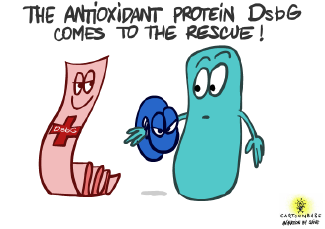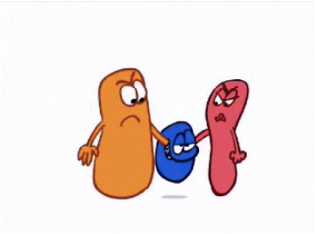Publication in the journal Science


Press Release

Press Release - Science
Biologists discover bacterial defense mechanism against aggressive oxygen
Brussel, November 19th 2009 - Bacteria possess an ingenious mechanism for preventing oxygen from harming the building blocks of the cell. This is the new finding of a team of biologists that includes Joris Messens of VIB, a life sciences research institute in Flanders, Belgium, connected to the Vrije Universiteit Brussel. The scientists made this discovery by modifying the DNA of the intestinal bacterium Escherichia coli. By means of this model organism, they have uncovered the existence of a mechanism that repairs proteins in the cell that have been damaged by oxygen. There are indications that a similar repair system is active in human cells. The research results are being published in the eminent scientific journal Science. At the same time, the researchers are posting an animation online that illustrates the finding.
Proteins are extremely sensitive to oxidation
Proteins are the most important components of our body’s cells. They aid the chemical reactions in the cell, provide structure and support, and facilitate communication within the organism. However, proteins are particularly sensitive to harmful effects from oxygen (oxidation). This is certainly the case for proteins that contain sulfurous components, with the amino acid cysteine as the basis. This is why the cysteine building blocks often occur as pairs, in which the bond between the two sulfur atoms provides protection.
But the cell also contains proteins in which the cysteine building blocks appear alone. How these single cysteines have been protected against oxygen has been unclear. Until now. Studying E. coli, the team of scientists, under the leadership of Jean-François Collet of the de Duve Institute (UCLouvain), has identified how two proteins - DsbG and DsbC - form the basis of an ingenious repair mechanism. Should the cysteine building block of a protein become damaged by oxygen, one of the two proteins takes care of repairing the damage.
Oxygen, a necessary evil
Oxygen is vital to the respiration of almost all cells. Among other things, the cells use the gas in the process of burning sugars to produce energy. But oxygen is a very aggressive molecule and can do serious harm to the cell’s building blocks. This damage can be compared to the rusting or oxidation of iron. “Sulfurous proteins are extra-sensitive to oxidation,” explains Joris Messens (VIB / the Vrije Universiteit Brussel). “If they become oxidized, they lose their functioning. This research clarifies how the cell arms itself against this event. Scientists have wondered for a long time what the function of DsbG and DsbC is and the difference between them. Now, finally, we have an answer.”
Notes for the editor
Contact details:
VIB Communications
Joris Gansemans:
+32 472 59 40 67
VIB/VUB
Joris Messens:
+32 478 91 12 88
de Duve instituut/UCLouvain
Jean Francois Collet:
+32 2 764 75 62
Relevant scientific publication
Matthieu Depuydt, Stephen E. Leonard, Didier Vertommen, Katleen Denoncin, Pierre Morsomme, Khadija Wahni, Joris Messens, Kate S. Carroll and Jean-François Collet. A Periplasmic Reducing System Protects Single Cysteine Residues from Oxidation, Science 326, p. 1109-1111
Funding
This work is supported by VIB, VUB, UCL en FRS-FNRS.
Mention both VIB and the university
When reporting this research, please always mention VIB as well as the university concerned.
VIB
VIB is a non-profit research institute in the life sciences in Flanders, Belgium. 1200 scientists conduct strategic basic research on the molecular mechanisms that control the functioning of the human body, plants, and micro-organisms. Through partnership with four Flemish universities − Ghent University, the Katholieke Universiteit Leuven, the University of Antwerp, and the Vrije Universiteit Brussel − and a solid investment program, VIB unites the forces of 70 research groups in a single institute. VIB’s research aims at fundamentally extending the frontiers of our knowledge. Through its technology transfer activities, VIB strives to convert the research results into products for the benefit of consumers and patients. VIB also develops and distributes a broad range of scientifically substantiated information about all aspects of biotechnology. More info at www.vib.be .
VUB
The Vrije Universiteit Brussel is located in the heart of Belgium and Europe. In 1969-1970 it budded off from the Université Libre de Bruxelles (ULB, °1834). The university combines excellent education and research. Several of the 150 research groups are of world class. For the Vrije Universiteit Brussel the principle of Free Research is paramount. But just as important is the quality of its bachelor and master programs, where students are no numbers, and where there is room for individual coaching and self-development. Today the Vrije Universiteit Brussel counts more than 9000 students and 2700 staff members, in eight faculties and two campuses in Brussels. At the medical campus also is located the Academical Hospital, with a staff of 3000. More info at www.vub.be.
This research has been done by Joris Messens, from the VIB Department of Molecular and Cellular Interactions, Vrije Universiteit Brussel
http://redox.vub.ac.be/BCRB/home.html
Persbericht - Wetenschap
Biologen ontrafelen verdedigingsmechanisme van bacteriën tegen agressief zuurstof
Brussel, 19 november 2009 - Bacteriën bezitten een ingenieus mechanisme om te voorkomen dat zuurstof de bouwstenen van de cel aantast. Dat heeft een groep biologen ontdekt, onder wie Joris Messens van het Vlaams Instituut voor Biotechnologie (VIB), verbonden aan de Vrije Universiteit Brussel. De wetenschappers deden de ontdekking door het genetisch materiaal van de darmbacterie Escherichia coli aan te passen. Uit het onderzoek blijkt dat de cel zwavelhoudende eiwitten actief herstelt wanneer die door zuurstof worden aangetast. Alles wijst erop dat ook bij de mens een soortgelijk reparatiesysteem actief is. De resultaten verschijnen in het wetenschappelijke toptijdschrift Science. Tegelijkertijd verspreiden de wetenschappers een online animatie die de bevinding illustreert.
Eiwitten erg gevoelig voor oxidatie
Eiwitten vormen de belangrijkste bouwstenen van al onze cellen. Maar ze zijn bijzonder gevoelig voor aantasting door zuurstof (oxidatie). Dat is zeker het geval bij eiwitten die zwavelhoudende componenten bevatten, met als basis het aminozuur cysteïne. Daarom komen die cysteïne-bouwstenen vaak als duo’s voor, waarbij de hechting tussen de twee voor bescherming zorgt. Toch bevat de cel ook eiwitten waar de cysteïne-bouwstenen als single voorkomen. Hoe die werden beschermd tegen zuurstof is lange tijd onduidelijk gebleven. Tot nu. Het team wetenschappers, onder leiding van Jean-François Collet van het de Duve Instituut (UCLouvain), identificeerde bij E. coli hoe twee eiwitten, DsbG en DsbC, de basis vormen van een ingenieus reparatiemechanisme. Raakt de cysteïne-bouwsteen van een eiwit beschadigd door zuurstof, dan zorgt één van de eiwitten voor herstelling van de schade.
Zuurstof, een noodzakelijk kwaad
Zuurstof is levensnoodzakelijk bij de ademhaling van zowat alle cellen. Die gebruiken het gas onder meer bij het verbranden van suikers om energie te produceren. Maar zuurstof is een erg agressief molecule, dat de bouwstenen van de cel zwaar kan aantasten. Dat valt te vergelijken met verroesten of oxideren van ijzer.
“Zwavelhoudende eiwitten zijn extra gevoelig voor oxidatie,” legt Joris Messens van VIB, verbonden aan de Vrije Universiteit Brussel, uit. “Raken die geoxideerd, dan verliezen ze hun werking. Dit onderzoek maakt duidelijk hoe de cel zich daartegen wapent. Wetenschappers vroegen zich al lang af wat de functie van en het verschil tussen DsbG en DsbC was. Eindelijk hebben we daar een antwoord op.”
Noten voor de redactie
Contact:
VIB Communicatie
Joris Gansemans
+32.472 59 40 67
VIB/VUB
Joris Messens
+ 32 478 91 12 88
de Duve instituut/UCLouvain
Jean Francois Collet
+ 32 2 764 75 62
Relevante wetenschappelijke publicatie
Matthieu Depuydt, Stephen E. Leonard, Didier Vertommen, Katleen Denoncin, Pierre Morsomme, Khadija Wahni, Joris Messens, Kate S. Carroll and Jean-François Collet. A Periplasmic Reducing System Protects Single Cysteine Residues from Oxidation, Science 326, p. 1109-1111
Financiering
VIB, VUB, UCL en FRS-FNRS
Vermelding VIB en universiteit
Wanneer u over dit onderzoek bericht, vragen wij u vriendelijk om steeds zowel VIB als de betrokken universiteit te vernoemen.
VIB
VIB is een non-profit onderzoeksinstituut in de levenswetenschappen. Zo’n 1200 wetenschappers verrichten basisonderzoek naar de moleculaire mechanismen die instaan voor de werking van het menselijk lichaam, planten en micro-organismen. Door een hecht partnerschap met vier Vlaamse universiteiten – UGent, K.U.Leuven, Universiteit Antwerpen en Vrije Universiteit Brussel – en een stevig investeringsprogramma bundelt VIB de krachten van 70 onderzoeksgroepen in één instituut. Hun onderzoek heeft tot doel de grenzen van onze kennis fundamenteel te verleggen. Met zijn technologie-transfer beoogt VIB de omzetting van onderzoeksresultaten in producten ten dienste van de consument en de patiënt. VIB ontwikkelt en verspreidt een breed gamma aan wetenschappelijk onderbouwde informatie over alle aspecten van de biotechnologie. Meer info op www.vib.be.
VUB
De Vrije Universiteit Brussel is een bloeiende universiteit in het hart van België en van Europa, die zich in 1969-1970 afsplitste van de Université Libre de Bruxelles (ULB), opgericht in 1834. De universiteit combineert uitstekend onderwijs met excellent onderzoek. Een aantal van de 150 VUB-onderzoeksgroepen behoort tot de absolute wereldtop. Voor de VUB staat het principe van vrij onderzoek centraal. Maar even belangrijk is de kwaliteit van de bachelor- en masteropleidingen in een omgeving waar studenten geen nummers zijn en waar ruimte is voor individuele begeleiding en zelfontplooiing. Vandaag telt de Vrije Universiteit Brussel ruim 9000 studenten en 2700 personeelsleden, verdeeld over acht faculteiten en twee Brusselse campussen: een in Etterbeek/Elsene en een in Jette. Bij de medische campus in Jette ligt ook het Universitair Ziekenhuis van de Vrije Universiteit Brussel met 3000 personeelsleden.
Het onderzoek gebeurde door Joris Messens van het VIB Departement Moleculaire en Cellulaire interacties, Vrije Universiteit Brussel.
http://redox.vub.ac.be/BCRB/home.html
Etude UCL en biochimie
Nouveaux espoirs dans la lutte contre le vieillissement cellulaire
L’équipe du professeur Jean-François Collet de l’Institut de Duve de l’UCL a mené une étude portant sur les systèmes de protection des protéines contre l’oxygène. La mise en lumière de ces mécanismes antioxydants ouvre des perspectives intéressantes dans la lutte contre le vieillissement cellulaire. Les résultats de ces recherches sont publiés dans la prestigieuse revue scientifique Science.
Les protéines de notre corps vivent dans un monde oxygéné. Une situation qui n’est pas sans risque. Comme la plupart des molécules biologiques, les protéines peuvent être endommagées suite aux attaques de certains dérivés de l’oxygène. Leur talon d’Achille est un acide aminé appelé « cystéine ». Ces cystéines sont très sensibles et se font facilement oxyder, ce qui peut dégrader les protéines de façon irréversible.
Pour être plus fortes et se protéger plus efficacement contre l’oxygène, certaines cystéines s’unissent, formant un couple uni par un « pont disulfure ». A deux, elles parviennent à résister aux assauts de l’oxygène.
Cependant, certaines protéines possèdent des cystéines célibataires plus vulnérables qui sont aisément attaquées par l’oxygène. Or ces cystéines sont souvent indispensables à l’activité de nombreuses protéines et donc essentielles au bon fonctionnement des cellules.
Les chercheurs ont étudié les mécanismes protecteurs qui rendent la cystéine plus résistante à l’oxydation, en particulier ceux qui se déroulent dans l’espace périplasmique (épaisseur de la membrane) des bactéries dites Gram-Négative. L’équipe du professeur Collet a ainsi découvert un nouveau système de protection des cystéines célibataires.
Les biologistes ont de bonnes raisons de croire que des mécanismes antioxydants similaires existent aussi chez l’homme.
Ces travaux de recherche ont été réalisés en collaboration avec la Vrije Universiteit Brussel et l’University of Michigan.
Les chercheurs ont, par ailleurs, mis au point un dessin animé visant à expliquer leur découverte et la rendre accessible au plus grand nombre.
.
Pour de plus amples renseignements (presse uniquement), n’hésitez pas à contacter :
• Jean-François Collet, chercheur qualifié FNRS au laboratoire de chimie physiologique de l’Institut de Duve de l’UCL: 00 764 75 62 ou jfcollet@umich.edu
Nov. 19, 2009
Saving the single cysteine: new antioxidant system found
ANN ARBOR, Mich.—We've all read studies about the health benefits of having a life partner. The same thing is true at the molecular level, where amino acids known as cysteines are much more vulnerable to damage when single than when paired up with other cysteines. Now, researchers at the University of Michigan, along with colleagues in Belgium, have discovered a new antioxidant system that protects single cysteines. The research appears in the Nov. 20 issue of the journal Science.
Our body's proteins, which are made up of amino acids and perform essential roles, can be injured by reactive species known as oxidants. Over time, the injuries can lead to cancer, heart disease, Alzheimer's disease and other serious medical conditions. To guard against such harm, our cells have special proteins that can repair or reverse oxidative damage. But until now, no such repair system had been identified for single cysteines, which are particularly susceptible to the damage.
In the current research, Carroll and colleagues used previously developed chemical probes to investigate and nail down the mechanism involved. "Our results reveal that a protein called DsbG serves this precise function in the periplasmic compartment in bacteria, protecting single cysteines residues from hyperoxidation and inactivation," said Carroll, an assistant professor of chemistry and a research assistant professor in the Life Sciences Institute. The periplasmic compartment is a space between the inner and outer membranes of bacteria such as Escherichia coli, which were used in this study. Although human cells have no periplasmic compartment, they have an equivalent membrane network called the endoplasmic reticulum.
"Since proteins from the DsbG family are widespread and have been identified in the majority of genomes including humans, some of these related members may play similar roles in controlling cysteine oxidation," Carroll said. A better understanding of these biological processes may lead to more effective antioxidant therapies.
Carroll's coauthors on the paper are Matthieu Depuydt, Katleen Denoncin and Jean-François Collet of the Université catholique de Louvain and the Brussels Center for Redox Biology; University of Michigan graduate student Stephen Leonard; Didier Vertommen and Pierre Morsomme of the Université catholique de Louvain; and Khadija Wahni and Joris Messens of Vrije Universiteit Brussel and Brussels Center for Redox Biology.



Press release VIB
Persbericht VIB
Communique UCL
News
University of Michigan
